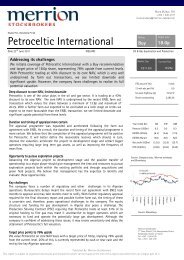Quarterly Bulletin Q3 2013
Quarterly Bulletin Q3 2013
Quarterly Bulletin Q3 2013
You also want an ePaper? Increase the reach of your titles
YUMPU automatically turns print PDFs into web optimized ePapers that Google loves.
9<br />
The Domestic Economy<br />
Overview<br />
n Annual National Accounts data for 2012<br />
point to a significant slowdown in the<br />
Irish economy last year, with GDP growth<br />
moderating to 0.2 per cent from 2.2 per<br />
cent in the previous year. The slowdown last<br />
year was mainly due to a marked decline<br />
in the growth rate of exports. This reflected<br />
a progressive deterioration of demand<br />
conditions in most of Ireland’s main trading<br />
partners. Domestic demand also contracted<br />
but at a much slower pace than in the<br />
previous year.<br />
n<br />
n<br />
The progressive deterioration in export<br />
performance during 2012 became more<br />
acute in the first quarter of this year<br />
when exports declined at an annual rate<br />
of 4.1 per cent. Two factors are likely to<br />
have accounted for this relatively weak<br />
performance. The first was weak external<br />
demand, most notably in the euro area but<br />
also in the UK. The second was the negative<br />
impact on goods exports of patent expiry in<br />
the pharmaceutical sector which accounts<br />
for a large share of overall goods exports.<br />
Recent indicators point to a projected<br />
recovery in exports in the remainder of this<br />
year and this is expected to gather strength<br />
next year in line with a projected, but<br />
uncertain, recovery in external demand.<br />
The outturn for domestic demand was<br />
also quite weak in the first quarter of <strong>2013</strong>.<br />
Consumer spending was particularly<br />
muted and this has motivated a downward<br />
revision in the forecast for consumption<br />
growth in <strong>2013</strong>. The sharp annual decline<br />
of 20 per cent in investment reflects the<br />
distortionary impact of aircraft investment,<br />
which conceals an incipient recovery in<br />
other machinery and equipment expenditure<br />
and non-housing construction. In the case<br />
of housing completions, although these are<br />
down in the year to May, leading indicators<br />
point to the potential for an increase for<br />
the year as a whole. Domestic demand<br />
is expected to stabilise this year and to<br />
make a small positive contribution to overall<br />
GDP growth which is projected at 0.7 per<br />
cent for <strong>2013</strong>. This projection represents a<br />
downward revision of about 0.5 per cent<br />
compared to the previous <strong>Bulletin</strong>.<br />
n The trend in GNP, which expanded by 1.8<br />
per cent last year following contraction of<br />
1.6 per cent in 2011, is not reflective of<br />
underlying conditions in the Irish economy.<br />
The gap between Irish GDP and GNP is<br />
driven by profit repatriation by multinational<br />
firms located here (See Box B). In recent<br />
years, net factor income outflows have been<br />
reduced by profit inflows from foreign owned<br />
PLCs that are domiciled in Ireland but are not<br />
engaged in any meaningful economic activity<br />
here. This has had the effect of boosting<br />
the growth rate of GNP in some years, most<br />
notably 2010 and 2012.<br />
n<br />
n<br />
Labour market conditions are showing clear<br />
signs of improvement. Following a marginal<br />
annual increase in the fourth quarter of<br />
2012, the first for 5 years, the numbers at<br />
work increased by 20,500 year-on-year in<br />
the first quarter of this year. The number<br />
unemployed fell by 29,900 – the largest<br />
such fall since Q1 1999. The increase in<br />
employment reflected a rise in part-time<br />
work. Reflecting recent improvements, the<br />
rate of unemployment is expected to fall in<br />
<strong>2013</strong> due to a combination of an increase<br />
in employment and a small reduction in<br />
the size of the labour force. A return to<br />
stronger employment growth awaits a<br />
recovery in domestic demand which should<br />
begin in 2014. Nonetheless, our central<br />
projections imply a continuing high level of<br />
unemployment.<br />
The annual rate of HICP inflation averaged<br />
2 per cent in 2012 with higher energy<br />
prices being the main contributing factor,<br />
accounting for 1.1 percentage points of total<br />
inflation. For <strong>2013</strong>, energy price inflation is<br />
expected to be considerably weaker while<br />
domestically generated inflation should<br />
remain contained. As a consequence,<br />
inflation should weaken to 0.8 per cent in<br />
<strong>2013</strong>. A projected pick-up in HICP inflation<br />
to about 1.1 per cent in 2014 is motivated,<br />
in the main, by technical assumptions<br />
pointing to higher oil prices next year, which<br />
are subject to a high degree of uncertainty.




